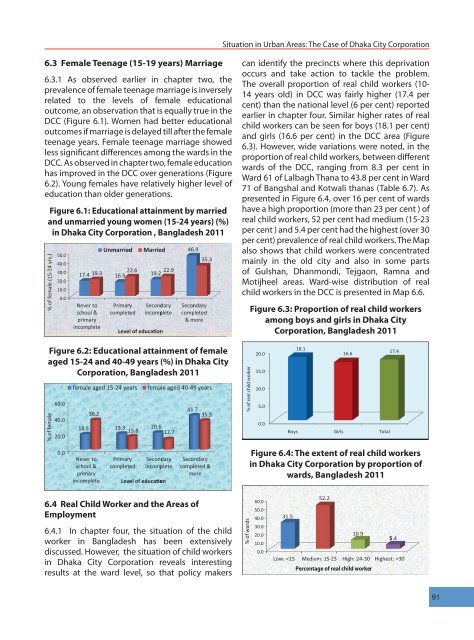Child Equity Atlas - BIDS
Child Equity Atlas - BIDS
Child Equity Atlas - BIDS
You also want an ePaper? Increase the reach of your titles
YUMPU automatically turns print PDFs into web optimized ePapers that Google loves.
Situation in Urban Areas: The Case of Dhaka City Corporation<br />
6.3 Female Teenage (15-19 years) Marriage<br />
6.3.1 As observed earlier in chapter two, the<br />
prevalence of female teenage marriage is inversely<br />
related to the levels of female educational<br />
outcome, an observation that is equally true in the<br />
DCC (Figure 6.1). Women had better educational<br />
outcomes if marriage is delayed till after the female<br />
teenage years. Female teenage marriage showed<br />
less significant differences among the wards in the<br />
DCC. As observed in chapter two, female education<br />
has improved in the DCC over generations (Figure<br />
6.2). Young females have relatively higher level of<br />
education than older generations.<br />
Figure 6.1: Educational attainment by married<br />
and unmarried young women (15-24 years) (%)<br />
in Dhaka City Corporation , Bangladesh 2011<br />
% of female (15-24 yrs.)<br />
50.0<br />
40.0<br />
30.0<br />
20.0<br />
10.0<br />
0.0<br />
17.4 19. 3<br />
Never to<br />
school &<br />
primary<br />
incompletee<br />
Unmarried<br />
22.6<br />
16.5<br />
Primary<br />
completed<br />
Married<br />
22.9<br />
19.2<br />
Secondary<br />
incomplete<br />
46.9<br />
35.3<br />
Secondary<br />
completed<br />
& more<br />
can identify the precincts where this deprivation<br />
occurs and take action to tackle the problem.<br />
The overall proportion of real child workers (10-<br />
14 years old) in DCC was fairly higher (17.4 per<br />
cent) than the national level (6 per cent) reported<br />
earlier in chapter four. Similar higher rates of real<br />
child workers can be seen for boys (18.1 per cent)<br />
and girls (16.6 per cent) in the DCC area (Figure<br />
6.3). However, wide variations were noted, in the<br />
proportion of real child workers, between different<br />
wards of the DCC, ranging from 8.3 per cent in<br />
Ward 61 of Lalbagh Thana to 43.8 per cent in Ward<br />
71 of Bangshal and Kotwali thanas (Table 6.7). As<br />
presented in Figure 6.4, over 16 per cent of wards<br />
have a high proportion (more than 23 per cent ) of<br />
real child workers, 52 per cent had medium (15-23<br />
per cent ) and 5.4 per cent had the highest (over 30<br />
per cent) prevalence of real child workers. The Map<br />
also shows that child workers were concentrated<br />
mainly in the old city and also in some parts<br />
of Gulshan, Dhanmondi, Tejgaon, Ramna and<br />
Motijheel areas. Ward-wise distribution of real<br />
child workers in the DCC is presented in Map 6.6.<br />
Figure 6.3: Proportion of real child workers<br />
among boys and girls in Dhaka City<br />
Corporation, Bangladesh 2011<br />
Figure 6.2: Educational attainment of female<br />
aged 15-24 and 40-49 years (%) in Dhaka City<br />
Corporation, Bangladesh 2011<br />
% of female<br />
60.0<br />
40.0<br />
20.0<br />
female aged 15-24 years<br />
18.5<br />
36.2<br />
19.3<br />
15.8<br />
female aged 40-49 years<br />
20.6<br />
12.7<br />
41. 7<br />
35.3<br />
% of real child worker<br />
20.0<br />
15.0<br />
10.0<br />
5.0<br />
0.0<br />
18.1<br />
16.6<br />
17.4<br />
Boys Girls Total<br />
0.0<br />
Never to<br />
school &<br />
primary<br />
incompletee<br />
Primary<br />
completed<br />
Level of<br />
Secondary<br />
incomplete<br />
on<br />
Secondary<br />
completed &<br />
more<br />
Figure 6.4: The extent of real child workers<br />
in Dhaka City Corporation by proportion of<br />
wards, Bangladesh 2011<br />
6.4 Real <strong>Child</strong> Worker and the Areas of<br />
Employment<br />
6.4.1 In chapter four, the situation of the child<br />
worker in Bangladesh has been extensively<br />
discussed. However, the situation of child workers<br />
in Dhaka City Corporation reveals interesting<br />
results at the ward level, so that policy makers<br />
% of wards<br />
60.0<br />
50.0<br />
40.0<br />
30.0<br />
20.0<br />
10.0<br />
0.0<br />
52.2<br />
31.5<br />
10.9<br />
5.4<br />
Low: 30<br />
Percentage of real child worker<br />
91














